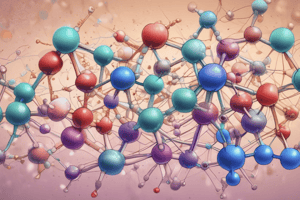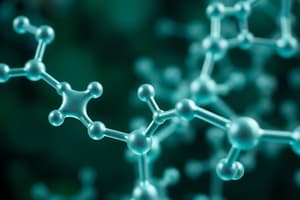Podcast
Questions and Answers
What does the presence of a chiral center in an amino acid imply?
What does the presence of a chiral center in an amino acid imply?
- The amino acid has no optical activity.
- The amino acid can exist in two stereoisomer forms. (correct)
- The amino acid is always an enantiomer.
- The amino acid has multiple chiral centers.
At physiological pH, what form do amino groups and carboxylic acid groups take?
At physiological pH, what form do amino groups and carboxylic acid groups take?
- Amino groups are unprotonated and carboxylic acid groups are protonated.
- Amino groups are protonated and carboxylic acid groups are unprotonated. (correct)
- Both are unprotonated.
- Both are protonated.
How are amino acids classified based on the properties of their R groups?
How are amino acids classified based on the properties of their R groups?
- By their pH level.
- By the number of chiral centers.
- By their polarity. (correct)
- By their molecular weight.
What defines the isoelectric point (pI) of an amino acid?
What defines the isoelectric point (pI) of an amino acid?
Which of the following correctly describes dipolar ions (zwitterions) of amino acids?
Which of the following correctly describes dipolar ions (zwitterions) of amino acids?
Which of the following amino acids would most likely be classified as having a charged polar R group?
Which of the following amino acids would most likely be classified as having a charged polar R group?
What is the effect of the pH on the ionization state of amino acid functional groups?
What is the effect of the pH on the ionization state of amino acid functional groups?
Why are the L stereoisomers of amino acids predominantly found in proteins?
Why are the L stereoisomers of amino acids predominantly found in proteins?
Which group is essential in distinguishing the different common amino acids?
Which group is essential in distinguishing the different common amino acids?
How are amino acids classified based on their properties?
How are amino acids classified based on their properties?
What structural components are shared by all 20 common amino acids?
What structural components are shared by all 20 common amino acids?
Which of the following amino acids was discovered most recently?
Which of the following amino acids was discovered most recently?
What significant role does the sequence of amino acids play in proteins?
What significant role does the sequence of amino acids play in proteins?
What is the common feature of the amino acid structure regarding its central carbon atom?
What is the common feature of the amino acid structure regarding its central carbon atom?
What is the formula to calculate the isoelectric point (pI) for basic amino acids?
What is the formula to calculate the isoelectric point (pI) for basic amino acids?
Which of the following amino acids cannot be synthesized by the organism and must be obtained from the diet?
Which of the following amino acids cannot be synthesized by the organism and must be obtained from the diet?
Which amino acid is incorrectly matched with its derivation?
Which amino acid is incorrectly matched with its derivation?
Which amino acid serves as a precursor for the hydroxylation modification in collagen?
Which amino acid serves as a precursor for the hydroxylation modification in collagen?
What important information can be derived from the similarity of amino acid sequences in proteins across different species?
What important information can be derived from the similarity of amino acid sequences in proteins across different species?
What is the role of carboxylation in amino acids?
What is the role of carboxylation in amino acids?
Which of the following amino acids is classified as non-proteinogenic due to its role as an intermediate in arginine biosynthesis?
Which of the following amino acids is classified as non-proteinogenic due to its role as an intermediate in arginine biosynthesis?
Which posttranslational modification is associated with serine, threonine, and tyrosine?
Which posttranslational modification is associated with serine, threonine, and tyrosine?
Which amino acid is often found in the structure of elastin, derived from lysine residues?
Which amino acid is often found in the structure of elastin, derived from lysine residues?
Which classification describes amino acids that are usually not essential but become necessary during illness or stress?
Which classification describes amino acids that are usually not essential but become necessary during illness or stress?
Flashcards are hidden until you start studying
Study Notes
Discovery of Amino Acids
- Asparagine was the first amino acid discovered in 1806 by French chemists Louis-Nicolas Vauquelin and Pierre Jean Robiquet.
- Threonine, discovered in 1935 by William Cumming Rose, is the last of the 20 common amino acids identified.
- Rose also determined essential amino acids and established daily minimum requirements for optimal growth.
Name Origins
- Amino acids derive their names from their sources:
- Asparagine from asparagus
- Glutamate from gluten
- Tyrosine from the Greek word "tyros" meaning cheese
- Glycine from "glykos," meaning sweet, due to its taste.
Protein Structure and Correlation
- Proteins are made up of diverse amino acids, as proposed by Emil Fischer and Franz Hofmeister in 1902.
- Amino acid sequences correlate with protein 3-D structures and functional classifications, indicating protein families.
- Similar sequences across species provide insight into evolutionary relationships.
Amino Acid Structure
- All 20 common amino acids have a shared structure, featuring an amino group (NH3+), carboxyl group (COO-), hydrogen atom, and unique R group attached to the α-carbon.
- R groups vary in structure, size, and charge, defining the distinct characteristics of amino acids and the resulting protein structure and function.
Stereochemistry
- Amino acids have a chiral center, presenting two possible stereoisomers, known as enantiomers.
- Nearly all amino acid residues in proteins are L stereoisomers, with only 1% existing as D configurations.
Amphoteric Nature
- Amino acids can function as acids or bases depending on their environment:
- In acidic solutions, carboxyl groups act as bases (accept protons).
- In basic solutions, amino groups act as acids (donate protons).
pH and Titration
- The pH scale ranges from 0-14, indicating acidity (0-6), neutrality (7), or alkalinity (8-14).
- pKa values for amino acids are approximately 2.2 for carboxylic acids and 9.4 for α-amino groups.
Zwitterions and Isoelectric Point
- At physiological pH, amino acids exist as dipolar ions or zwitterions with opposite charges but a net charge of zero.
- The isoelectric point (pI) is the pH at which an amino acid has no net charge:
- For monoamino, monocarboxylic acids (e.g., glycine), pI = (pK1 + pK2)/2.
- For basic amino acids (lysine, arginine, histidine), pI = (pKR + pK2)/2.
- For acidic amino acids (aspartate, glutamate), pI = (pK1 + pKR)/2.
R Group Classification
- Amino acids are categorized by R group polarity:
- Nonpolar R groups
- Uncharged polar R groups
- Charged polar R groups
- Protein structure is influenced by the tendency of polar and ionic side chains to be hydrated and nonpolar side chains to avoid water (hydrophobic interactions).
Uncommon Amino Acids
- Uncommon amino acids result from posttranslational modifications, such as:
- Phosphorylation of serine, threonine, and tyrosine.
- Hydroxylation of proline, found in collagen.
- Carboxylation of glutamate, involved in blood clotting (prothrombin).
- Desmosine, derived from four lysine residues, found in elastin (connective tissue).
- Ornithine and citrulline are non-proteinogenic amino acids associated with arginine biosynthesis and the urea cycle.
Essential, Non-essential, and Conditionally Essential Amino Acids
- Essential amino acids cannot be synthesized by the body and must be obtained through diet.
- Non-essential amino acids can be synthesized in sufficient quantities by the body.
- Conditionally essential amino acids are typically non-essential but become essential during illness or stress, such as in premature infants or individuals with significant catabolic stress.
Studying That Suits You
Use AI to generate personalized quizzes and flashcards to suit your learning preferences.




